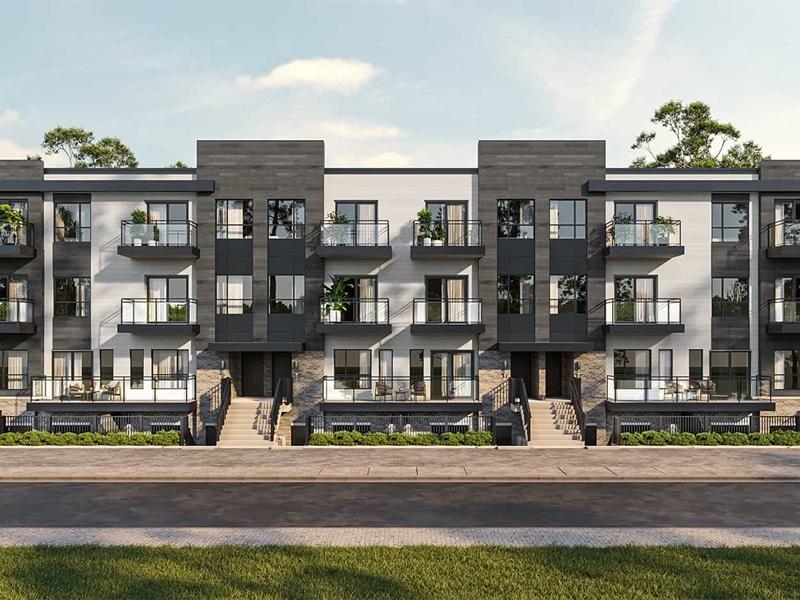
Toronto-based prefab homebuilder CABN has reworked its business model to sell only the building envelope, instead of finished homes, so the company can construct housing faster, at lower cost, and more sustainably.
CABN Core Technology, its name for the modified platform, is offered as a customizable system for the client's builder, or for a developer to make adjustments to the layout and choose the finishes they desire.
After working on larger projects and hearing from its clients, the company shifted gears to this model so it can focus on what it does best and run its operations more efficiently.
“We’ll work within the parameters of what a builder or an individual needs,” CABN’s founder and CEO Jackson Wyatt said in an interview with RENX Homes. “But what we did find is that a lot of customization becomes really tied in with the interior layouts and cabinetry.
“For us, we look at it as, we’ll work with you on finishing those pieces out, but need to know what you want first, then we can go from there.”
About Core Technology
Core Technology is offered with all of the company's existing housing models: from the one-storey, 1,100-square-foot LI.LO to the 2,500-square-foot LA.TIGO.
At its 93,000-square-foot Brockville, Ont. factory, CABN’s team can manufacture single-family, duplex and townhome models, as well as multifamily and commercial buildings, out of cross-laminated timber. Workers at the facility can assemble a one-bedroom home in approximately two days and produce the components for buildings as tall as six storeys.
With Core Technology the structural panels, insulation, membrane, strapping, cladding, and high-performance windows and doors are included. The building’s shell will be delivered closed, sealed and ready to go, Wyatt said.
Once a model is selected by the client and the interior layout decided, CABN will manufacture the envelope and ship it to the site in a flat pack kit. It can then be hooked up to utilities and have work on the finishes, such as cabinetry and appliances, take place.
The change to its business model will benefit both CABN and the industry players with boots on the ground, Wyatt said.
Offering Core Technology will lower costs and accelerate construction timelines by reducing shipping and local labour needs, he argues.
Wyatt gave the example of building housing in Northern Canada, where there is a short window of opportunity for construction, which increases costs. But CABN can assemble an envelope within days, and the finishes can be done indoors year-round, which reduces the pressures of a short building season.
Core Technology makes it is easier to gain approvals and navigate the permitting process by tapping into regionally licensed trades. Plus, it cuts back on transportation emissions by sourcing finishes and construction teams locally.
Altogether, Wyatt believes Core Technology will help increase housing supply by supporting local builders with scaling up.
“The ability to do six, seven homes a year versus two to three just because the envelopes go up really rapidly, it’s great for the communities, increases housing stock and it lifts and helps everyone in all these areas across Canada.”
Continuing CABN's focus on sustainability
Sustainability is key to Core Technology, with net-zero design a mainstay for all of its projects. CABN has designed two kinds of envelopes: one based on carbon-negative materials, and another that is decidedly climate-resilient.
The first option revolves around carbon-negative wood fibre insulation and sustainable options for cladding. A four-bedroom home can eliminate 62 tonnes of carbon dioxide after shipping and manufacturing because of the use of cross-laminated timber, Wyatt said.
The climate-resilient envelope focuses on a non-combustive mineral wool insulation, aluminum cladding and a steel roof, designed for greater protection against natural disasters such as wildfires.
“It’s really about showcasing that there’s two lanes. Both lanes are very sustainable and very resilient, but allows you to choose your path based on your location and climate,” Wyatt said.
The envelope for the carbon-negative home costs between $180 to $189 per square foot, while the climate-resilient version is priced between $185 to $200 per square foot.
CABN intends to sell Core Technology to builders, developers and municipalities. Already 1,000 individuals and builders are on a wait list, Wyatt said.
It is geared toward suburbs and rural areas facing a shortage of housing, he said, not so much dense, urban areas because the environment could interfere with the solar energy generation component.
Over 30 projects using Core Technology are underway across Canada and the U.S., Wyatt added, in locations as diverse as Muskoka (Ontario's cottage country region), Vancouver, Cape Breton Island and in Virginia.










